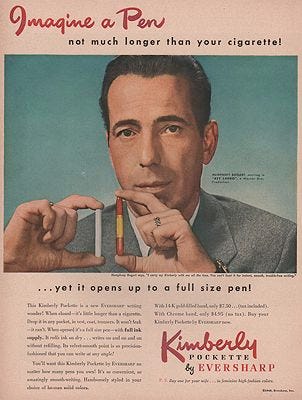Jonathan Wells recently shared information about the writing styles and favorite writing instruments of some of the world’s most famous authors in an article for Gentleman’s Journal. Truman Capote used yellow legal pads, for instance, while Vladimir Nabokov, the author of Lolita, composed almost alI his works on index cards.
John Steinbeck was a pencil guy, preferring the Palomino Blackwing, employing an intricate system that used 24 sharpened pencils in succession. At the end of the novel Dreamcatcher, Stephen King let his preference be known with the statement, “This book was written with the world’s finest word processor, a Waterman cartridge fountain pen.”
Albert Einstein, meanwhile, favored a Pelikan 100N fountain pen, noted Wells.
I recall being mildly upset in high school when my father gave me a pen for my birthday. It was a cool pen but I didn’t appreciate it at the time. I don’t know what I was expecting, but I wish now I had taken better care of it. It was a solid little thing, a ballpoint in a dimpled steel casing. It had a nice mechanism when you engaged the pen point. When I clicked it down, I imagined I was in communication with UNCLE HQ. The Man from UNCLE was on TV at the time. A few months later, of course, I lost it.
What you find out when you look into the subject of pens is that they’re a lot like watches, offering workmanship and details you never knew existed. You can even take a tour of pen factories in countries like Germany, Italy, and Japan.
Pen people take their work seriously. The rules for touring the Sailor pen factory in Hiroshima, Japan read like a visit to a secret missile site: visitors must wear hair caps and are forbidden to speak to on-site workers. Photography is not allowed, and “entry will be denied for individuals under the influence of alcohol or accompanied by pets.”
Pens are still made here in the United States, too. While they don’t offer tours, the Fisher Space Pen company is located in Boulder City, Nevada. The company’s pens are famous for their unique ability to write in extreme conditions—even in zero gravity which explains why they’ve been used on numerous space missions (where a lot of writing goes on). Your basic space pen goes for $59, by the way.
I found a list of 100 recommended pens online—with prices and everything. Along with roller-ball, felt-tip, and gel models, there were a number of the fancy fountain pens people like to rave about. I had a fountain pen once. I have to admit that having the ink flow across the paper was a rush, but a fountain pen can also be a scratchy thing, while always presenting the possibility of a mess.
Graham Greene, the British mystery writer who wrote the screenplay for two of my film noir favorites, The Fallen Idol and The Third Man (both directed by Carol Reed), also favored the fountain pen. “My two fingers on a typewriter have never connected with my brain,” he said. “My hand on a pen does. A fountain pen, of course. Ballpoint pens are only good for filling out forms on a plane,” said Greene.








Interesting post. While it's not a fountain pen and a cheap, disposable one, my favorite pen has come to be a Japanese Zebra gel rollerball pen with 1.0 mm nib black refills. I love the thickness and weight of the lines they make.